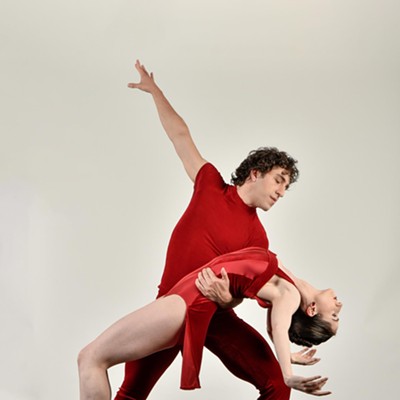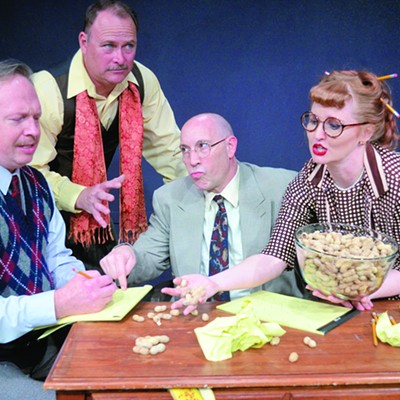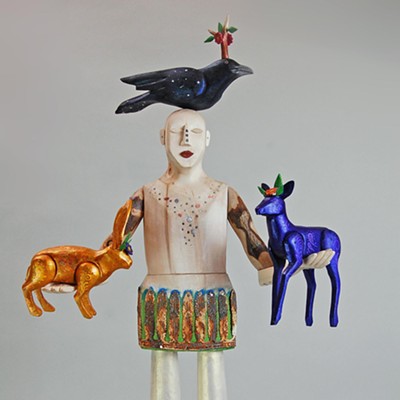Books and Basketball
David Bagga Book-signing
1:30 to 3 p.m., Sunday, Feb. 21
UA Bookstore at the McKale
Memorial Center
1721 E. Enke Drive
621-2183
It is Nov. 9, 2005, and the fans at McKale Memorial Center are creating a blur of noise and movement. The Wildcats are playing Sonoma State in the first exhibition game of the season, and only one player has not yet gotten playing time: the walk-on.
Later in the game would come David Bagga's first attempted—and missed—jump shot. It's a good thing that Bagga isn't the kind of guy who gives up.
"I made about 300 phone calls, just trying so hard to crack my way onto a team," Bagga said. His hard work paid off when he was invited to join the Wildcats.
"I was so nervous at first," Bagga said. "I had no idea if I was going to get cut."
In his book, The Walk-On, Bagga details his story of walking on to one of Division I college basketball's top teams and playing alongside future NBA athletes such as Jordan Hill and Chase Budinger—plus working with coach Lute Olson.
Bagga will be signing copies of his book at the McKale Sports Stop before the basketball game against Arizona State University.
Bagga's basketball career ended on a high note in 2009, when Arizona was down, and he shot a 3-pointer on Senior Day against Stanford.
"McKale was so loud that I couldn't hear anything else," Bagga said.
This Walk-On has been a four-year project and was written in the hopes that it will be inspiring.
"It was written to impact people who were told they weren't good enough, not fast enough," he said. "Because I was one of those guys. I was told that.
"I just really want to show people that all you need is a window of opportunity."
Admission to the book-signing is free. —S.F.
Danger Within
Reading by John D'Agata
8 p.m., Monday, Feb. 22
UA Poetry Center
1508 E. Helen St.
626-3765;
At one time, the prospect of sealing America's nuclear waste inside a mountain 90 miles northwest of Las Vegas seemed like a sure thing. But this month, the Yucca Mountain project was officially declared dead, thanks to budget cuts.
It is off-the-wall subjects such as these that pique the interest of John D'Agata, an Iowa author who will be visiting the University of Arizona Poetry Center on Monday. He will be reading from his newly published book, About a Mountain, a project nine years in the making.
"I like boring into a subject," D'Agata said, "not only trying to figure out what fascinates me about it, but finding more significance than its silly surface it might suggest."
The Yucca Mountain issue is not necessarily silly, but to some, it may seem bizarre. Officials worked on the project for more than 20 years, tackling topics such as how to mark a mountain as "dangerous," and how to develop materials that can withstand 10,000 years of wear and tear, since that is the estimated half-life of nuclear waste.
However, President Barack Obama eliminated funding for the project at the beginning of the month.
The book concentrates on many issues that legislators have faced, including how to communicate the hidden dangers of the mountain to people in the future.
On Monday, D'Agata will read from his book, which touches on these Yucca Mountain subjects and many others. His previous book, Halls of Fame, was a collection of essays of varying subjects, including a piece on the brightest light in the world.
If D'Agata's choice of subject matter is any indication, his reading will certainly be illuminating.
Admission to the reading is free. —S.F.
Transported Fairy Tale
Pima Community College presents Cinderella
7:30 p.m., Wednesday-Saturday; 2 p.m., Sunday, through March 7 (Wednesday, Feb. 24 is a preview)
PCC Proscenium Theatre
Pima Community College West Campus
2202 W. Anklam Road
206-6986;
See Cinderella like you've never seen her before—namely, in a sari with a four-armed Hindu goddess for a godmother.
Todd Poelstra, program coordinator for theatre arts at Pima Community College, has been directing plays at Pima for eight years. He said he's excited about this performance of Cinderella, because it is the Rodgers and Hammerstein version from 1957 with a twist—it takes place in India.
"It has somewhat of a Bollywood feel to it. The set, the costumes and the dance movements are all traditional in India," said Poelstra.
"Rodgers and Hammerstein's music is just luscious. That classic kind of theater waltz music, when mixed with the Bollywood dances, it's just gorgeous," said Poelstra.
He said that when you combine the traditional music with such a different setting, you get to see the play in a whole new way.
"With this combination, you get to really see Cinderella, not the Disney version or the Whitney Houston version. You get to see her plight for what it is. For many people, it might be the first time they get to really see it," he said.
The play has been updated to fit the times. Poelstra said this is important, because this is a time when gender issues and gender roles are changing.
"We like her, and the prince likes her, but for reasons other than she's pretty," said Poelstra.
He added: "We're all Cinderella. We all want to go to the ball. We all want to find true love."
Tickets are $18, with discounts available for students, seniors, groups and preview night. —T.D.
Life in Our Region
Western Round Up by Barry Sapp and Susan Evans
Opening Reception: 5 to 8 p.m., Friday, Feb. 19
Exhibit continues 10 a.m. to 6 p.m., Monday-Saturday; 9 a.m. to 5 p.m., Sunday, through March 5
Jane Hamilton Fine Art
2890 E. Skyline Drive, Suite 180
529-4886;
Two artists with rather different painting styles are coming together to showcase a common theme: life in the West.
Barry Sapp said he read an article in 2008 that scrutinized the new generation of Southwestern artists for not including enough figures to therefore tell the true story. Since then, he's been adding more figures to his paintings.
"I took this to heart and really set out to tell more of a story with my paintings," said Sapp. One example is "Hopi Snake Dance." The work started off with only two characters, but Sapp then decided to add a third man and finally added in figures watching from a distance. Sapp spends weeks researching Hopi rituals before he begins to paint them.
Sapp also paints more traditional Southwest scenes. "My paintings are reminiscent of the old guys coming into Tucson and not finding much but a lot of cactus and a little water," he said.
Sapp's presentation of his paintings is also somewhat different; he seals the works to protect them from spills and sunlight. "I feel it's as archival as having it under glass or plastic, without the bother of reflections," said Sapp.
Susan Evans uses the technique of chiaroscuro, which is Italian for "light to dark." She makes her paintings come to life by painting light and shadows into the scene.
Two paintings Evans receives many compliments on are "Prickly Pear," a stylized painting, and "Pear Presence," a more classic painting.
One of her favorites, "Bovine Design," depicts a brown-and-white chair.
"That little chair has a great deal of presence," said Evans.
Admission to the event is free. —T.D.








